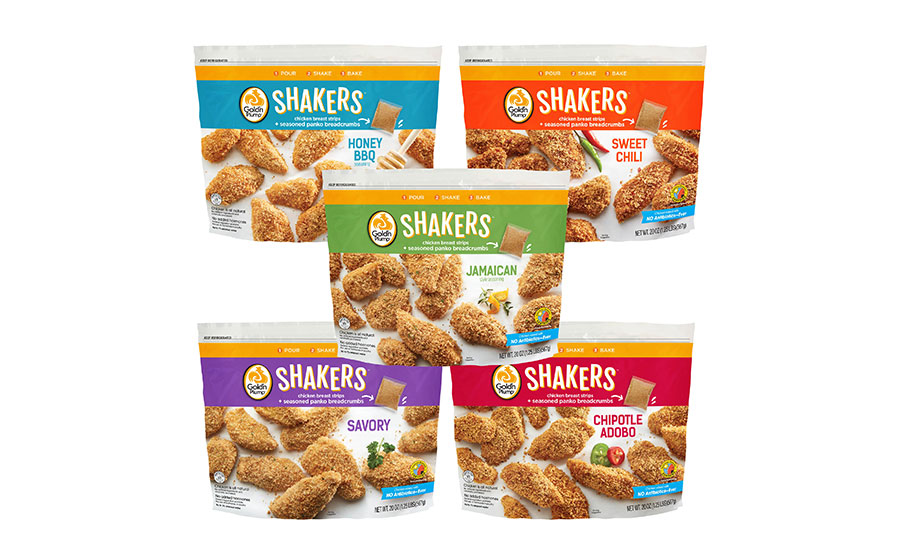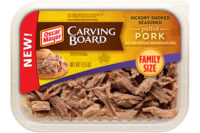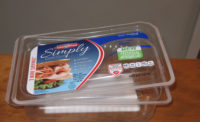The popularity of reclosable packaging shows no signs of decreasing. Consumers love its ability to protect product freshness without rewrapping or transferring remaining servings into a reusable container. Beyond its usual storage function, however, reclosable packaging is beginning to play a more active role, particularly with the meal and entrée kits being introduced to address the growing demand for semi-homemade foods.
The kits streamline meal preparation by supplying ingredients for quick assembly and cooking. Reclosable packaging provides an ideal vehicle for marinating, breading or ingredient mixing. A good example is Gold’n Plump Shakers chicken breast strip kits, introduced in the second half of 2016 by GNP Company, in Saint Cloud, Minn. Each 20-ounce kit includes 16 ounces of fresh, whole-muscle chicken breast strips in an easy-open pouch, 4 ounces of seasoned Panko-style breadcrumbs, and a zip-seal bag for shaking.
Ready in 20 minutes, the refrigerated chicken strips are prepared for use in pasta, salads, wraps or sandwiches. Preparation is streamlined to three, virtually no-touch steps: Remove pouch of chicken and pouch of bread crumbs from outer pouch; open bread crumb pouch and pour crumbs into outer pouch, peel open chicken pouch and put chicken into outer pouch, zip outer pouch and shake; open and place the coated chicken pieces on a baking sheet or in a fry pan. Each 20-ounce bag of shakers chicken breast strips holds four servings and carries a suggested retail price of $5.99. Flavors include Savory, Sweet Chili, Jamaican, Honey Barbeque and Chipotle Adobo.
Zipper pouches are making inroads for other refrigerated ready-to-eat or -heat products. Trident Seafoods Corp., in Seattle, Wash., relies on an 8-ounce zipper pouch with an easy-open tear notch for Louis Kemp Chunk Style Crab Delights fully cooked imitation crabmeat. A double-track press-to-close zipper on a form-fitting thermoformed pouch protects patties and links of fully cooked sausage from Johnsonville Sausage, in Sheboygan Falls,Wis.
Zipper reclosures also are commonly seen on bulk bags of frozen uncooked products such as chicken pieces and fish fillets and frozen cooked products such as meatballs or chicken breasts. For example, another fully cooked Johnsonville Sausage product, Flame Grilled chicken breasts, resides in a tear-notched standup pouch with a single-track zipper. Sold frozen, the standup pouch holds three chicken breasts, each in its own sealed pouch. Flavors include Honey Mustard Glazed, Garlic and Herb, Teriyaki Glazed, Black Pepper and Sea Salt, and Southwestern.
Applied during the form-fill-seal process or supplied on pre-formed pouches, zipper reclosures combine online productivity with consumer convenience. In addition, profiles can be supplied in a variety of colors to enhance visibility and support brand identity. The latest designs maximize sealing efficiency and side seal integrity while minimizing material usage.
Slider zippers, which operate more like a zipper on a jacket, also offer performance and sustainability improvements. Lower-profile, ergonomically designed mechanisms reduce material consumption and drag force.
It should be noted that zippers are not the only reclosure option for flexible packaging. Once opened, some multi-serving bags are designed to be folded over several times and sealed in place with a pressure-sensitive tape strip. ConAgra Foods, in Omaha, Neb., relies on this reclosure method for 26.5-ounce bags of frozen Banquet fully cooked breaded chicken nuggets.
Another alternative, pressure-sensitive peel/reseal lidstock, simplifies opening and reclosing tray packs and form-fill-seal pouches, particularly those with a formed bottom web that cradles products such as pepperoni slices.
If rigid packaging such as clamshells and tubs is preferred, friction-fit lids can impart reclosability. Popular for sliced lunch meat and frozen soups such as lobster bisque or clam chowder, tubs also offer the potential for reuse. Typically made of microwave- and dishwasher-compatible polypropylene, the tubs and lids often end up in refrigerators, freezers and pantries to hold leftovers or products that don’t come in reclosable packaging and must be transferred out of their original packaging. NP




Report Abusive Comment